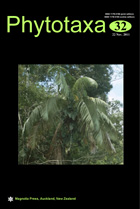Abstract
Microstachys nana and M. ditassoides subsp. villosa, two new taxa endemic to Brazil, are described, illustrated and compared with related species. Microstachys nana is closely related to M. glandulosa and is distinguished by its herbaceous habit, glabrous to glabrescent branches, pedicellate pistillate flowers, ovary with developed appendages, and inflorescences with spaced flowers. Microstachys ditassoides subsp. villosa is related to M. ditassoides subsp. ditassoides, from which differs by its densely villous branches, leaves with flat and sparsely serrate margins, oblong-obovate staminate sepals obtuse at the apex, and externally glabrous pistillate sepals with cylindrical lateral-basal glands. Two new combinations are proposed: Microstachys glandulosa is based on Cnemidostachys glandulosa, a Brazilian species with broadly elliptic to orbicular, pubescent leaves and marginal glands situated in small lateral lobes; Microstachys stipulacea is based on Gymnanthes stipulacea, as a glabrous species unusual for its long petioles and stipules and broadly elliptic to suborbicular leaves, and known from the border region between Brazil and Uruguay.

